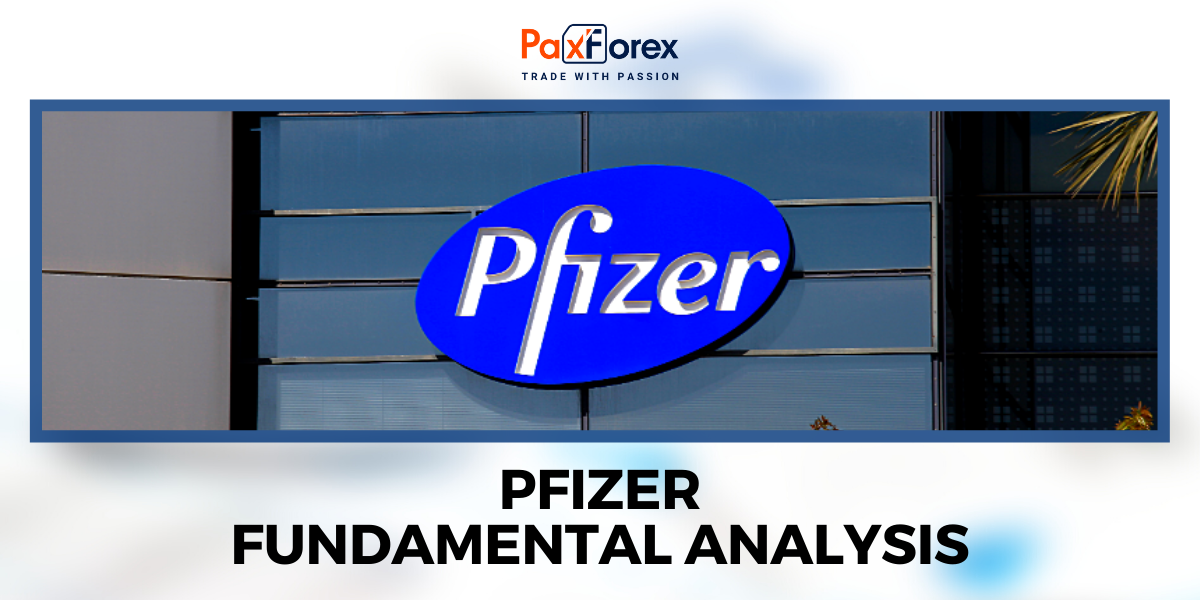
Source: PaxForex Premium Analytics Portal, Fundamental Insight
Pfizer, a well-known stock, has a range of opinions regarding its desirability as an investment. While its potential for consistent returns and a respectable dividend may be appealing, it's crucial for investors to grapple with uncertainties about its future growth trajectory before making a decision.
With that in mind, let's explore two contrasting viewpoints on the stock: one from the optimists (bulls) and one from the skeptics (bears). One common ground both sides share is the belief that Pfizer's future won't mirror its recent past.
The bullish perspective on Pfizer hinges on the company's ambitious strategic plan, which aims to boost its annual revenue to $84 billion by 2030. This strategy involves a combination of launching new drugs and pursuing acquisitions or asset purchases. Pfizer anticipates that the products it plans to introduce in the coming months could generate an annual sales volume of $20 billion by the end of the decade. This is in addition to the $25 billion in extra revenue expected from business development deals.
Pfizer is already taking tangible steps to translate this plan into reality, such as its acquisition of Seagen for a total of $43 billion to bolster its oncology portfolio. Furthermore, with 10 programs awaiting regulatory review and 23 phase 3 candidates in its pipeline, the company is positioned to launch multiple new drugs each year. Each successful launch not only has the potential to boost the stock but also contribute to increased sales.
Bullish investors also acknowledge that Pfizer's current valuation is notably attractive. Its price-to-earnings (P/E) ratio stands at a mere 9, well below the market's average P/E ratio of 25. If the multitude of new product launches convinces the market that Pfizer will grow its revenue at a faster pace than planned, it may result in an expansion of the valuation—a substantial additional advantage for investors.
While bullish investors foresee multiple factors driving Pfizer's success through 2030, skeptics are far from convinced that the company's strategic plan will deliver above-average returns. In essence, despite benefiting from a significant surge in its share price during the pandemic due to its successful coronavirus vaccine and the commercialization of antiviral therapy, Pfizer's total return has only increased by 2% over the last five years. This performance significantly lags behind the market's robust growth of 68%, and it has similarly failed to outperform the market over a 10- or 20-year span.
It's worth acknowledging that past performance doesn't necessarily predict future returns. However, a closer look reveals that over the past decade, Pfizer's trailing 12-month revenue, now standing at $78 billion, has grown by a modest 50%. If the grand strategic plan unfolds as advertised, the top-line figure in 2030 will only be $3 billion higher than in 2021, with a compound annual growth rate of just 10% from 2025 onward. This growth rate is unlikely to trigger significant share price appreciation, according to the bearish perspective.
Furthermore, short-term concerns loom large. Wall Street analysts project Pfizer's sales for 2023 to hover around $62 billion, with estimates for 2024 mirroring this figure. There's also the risk that revenue from coronavirus-related products could decline more rapidly than expected, even as the pandemic persists. With few unexpected positive catalysts on the horizon, the stock's affordable valuation seems justified in the eyes of the skeptics, implying limited near-term growth potential.
The bearish outlook suggests that Pfizer's stock may not shine in the coming years. However, beyond this period, there's a possibility that sentiment surrounding the company could improve as it executes more acquisitions and allows its pipeline to yield high-earning medicines. Nonetheless, it would be unrealistic to expect Pfizer's shares to outperform the market even then, as growth is expected to remain relatively sluggish, and it will likely take until well beyond the end of the decade to approach the heights seen in 2021.
Nevertheless, Pfizer is likely to maintain ample financial resources to pay and potentially increase its dividend, which currently boasts an appealing forward yield of nearly 5%. While bullish investors might be disheartened by its stock price performance, there is still potential to build a substantial passive income stream by acquiring Pfizer shares at a bargain and holding onto them for the long term.
As long as the price is above 35.00, follow the recommendations below:
- Time frame: D1
- Recommendation: long position
- Entry point: 33.60
- Take Profit 1: 37.50
- Take Profit 2: 38.50
Alternative scenario:
If the 35.00 level is broken-down, follow the recommendations below:
- Time frame: D1
- Recommendation: short position
- Entry point: 35.00
- Take Profit 1: 32.50
- Take Profit 2: 31.00













